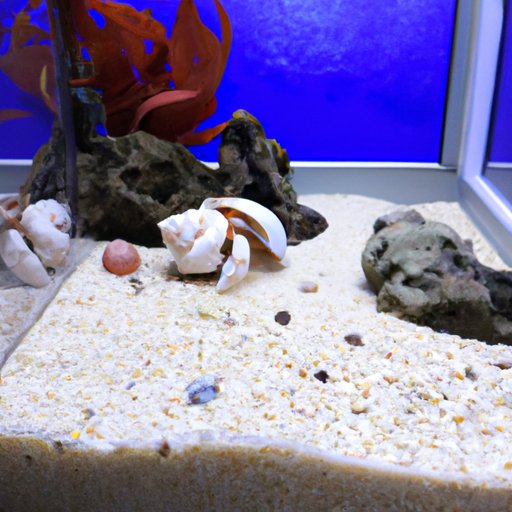Introduction
Hermit crabs are small crustaceans that have become popular pets in recent years. They are easy to care for, but it’s important to understand their needs before bringing one home. In this article, we’ll cover everything you need to know about creating a comfortable habitat and providing proper nutrition for your hermit crab.
Create a Habitat
The most important aspect of caring for a hermit crab is creating an appropriate habitat. This includes factors like substrate, temperature, humidity, and ventilation.
Substrate
The substrate is the material that lines the bottom of the tank. Common substrates for hermit crabs include sand, coconut fiber, and crushed coral. The substrate should be at least two inches deep to give them enough room to burrow and molt. Be sure to avoid substrates made of wood or other materials that could release toxins into the tank.
Temperature
Hermit crabs prefer temperatures between 70-85°F (21-29°C). To maintain this temperature range, you can use an under-tank heater or a reptile heating pad. It’s also important to keep the temperature consistent, so try to avoid placing the tank near windows or vents where it might get too hot or cold.
Humidity
The ideal humidity level for hermit crabs is between 70-80%. You can measure the humidity using a hygrometer, which is available at most pet stores. If the humidity is too low, you can increase it by misting the tank with dechlorinated water or adding a humidity hide. If the humidity is too high, you can reduce it by adding a fan or reducing the amount of misting.
Ventilation
Hermit crabs need a well-ventilated tank to stay healthy. Make sure the tank has several air holes, and consider adding a fan to increase air circulation. A screened top is also a good option to help keep humidity levels in check.
Feed Them Properly
Hermit crabs need a nutritious diet to stay healthy. Their diet should consist of a combination of dry foods, fresh fruits and vegetables, and protein sources such as cooked meat and eggs. To ensure they get all the nutrients they need, offer a variety of different foods every day. Avoid feeding them processed foods or anything with artificial colors or flavors.
Change the Substrate Regularly
It’s important to change the substrate regularly to keep the tank clean and free of bacteria. Aim to do a full substrate change every few weeks. When changing the substrate, make sure to remove any uneaten food or waste, as these can attract bacteria and cause health problems for your hermit crab.
Provide Access to Water
Hermit crabs need access to fresh, dechlorinated water. You can provide this by filling a shallow bowl or dish with the water and placing it in the tank. Be sure to change the water daily and clean the bowl or dish regularly to prevent bacterial growth.
Handle With Care
Although hermit crabs are generally docile, they can still be easily stressed. Try to limit handling your hermit crab, and when you do handle them, be sure to support their body with both hands. This will help keep them calm and reduce the risk of injury.
Monitor Health
It’s important to monitor your hermit crab’s health to make sure they’re happy and healthy. Pay attention to any changes in behavior, such as lethargy or aggression. Shedding is also normal for hermit crabs, but if you notice any discoloration or unusual shedding, take your hermit crab to the vet right away.
Conclusion
Caring for a hermit crab requires special consideration, but it’s not difficult once you understand their needs. By creating a comfortable habitat and providing a balanced diet, you can ensure your hermit crab stays healthy and happy. Remember to monitor their health and handle them with care, and you’ll have a wonderful pet for many years to come.


